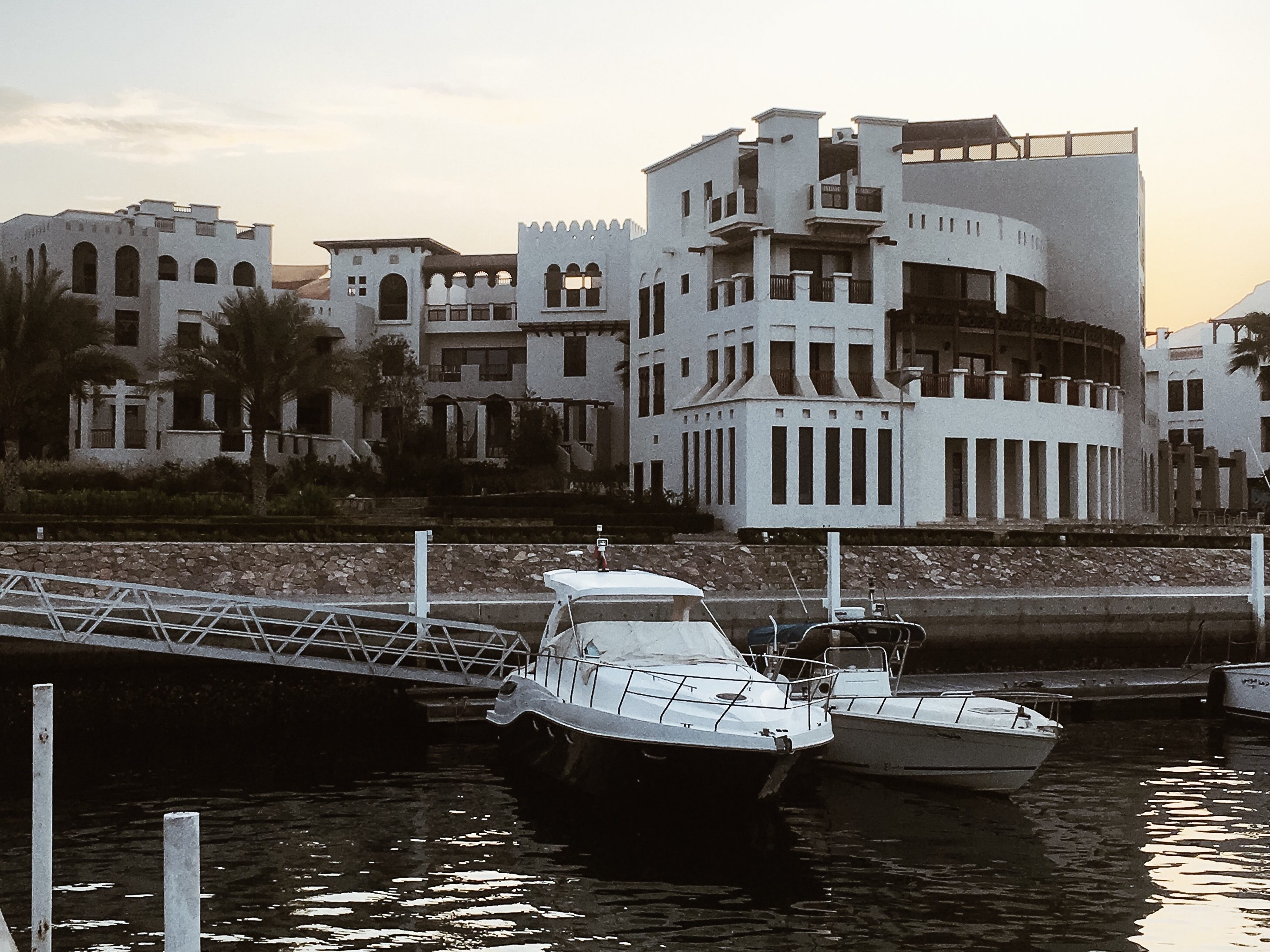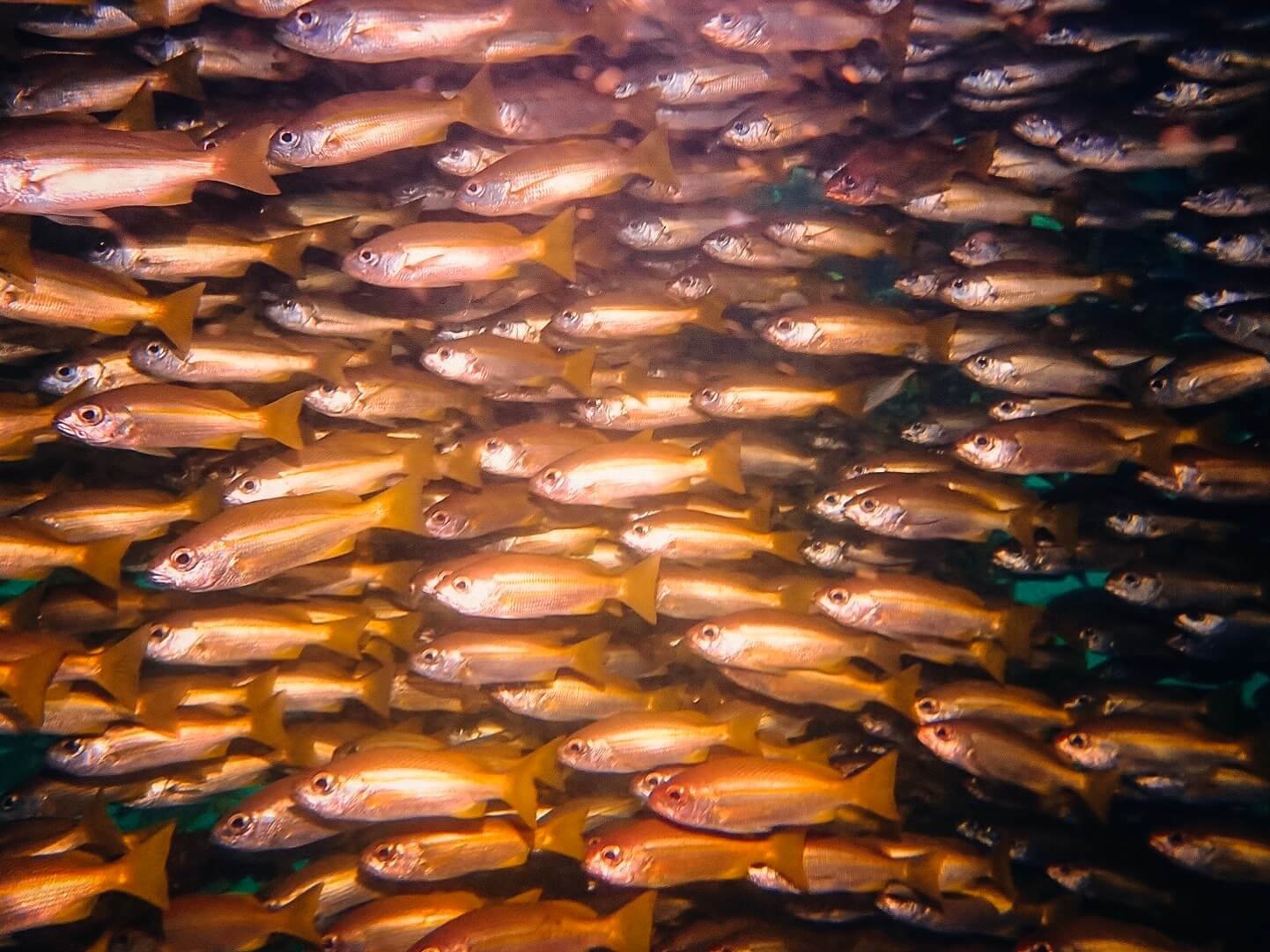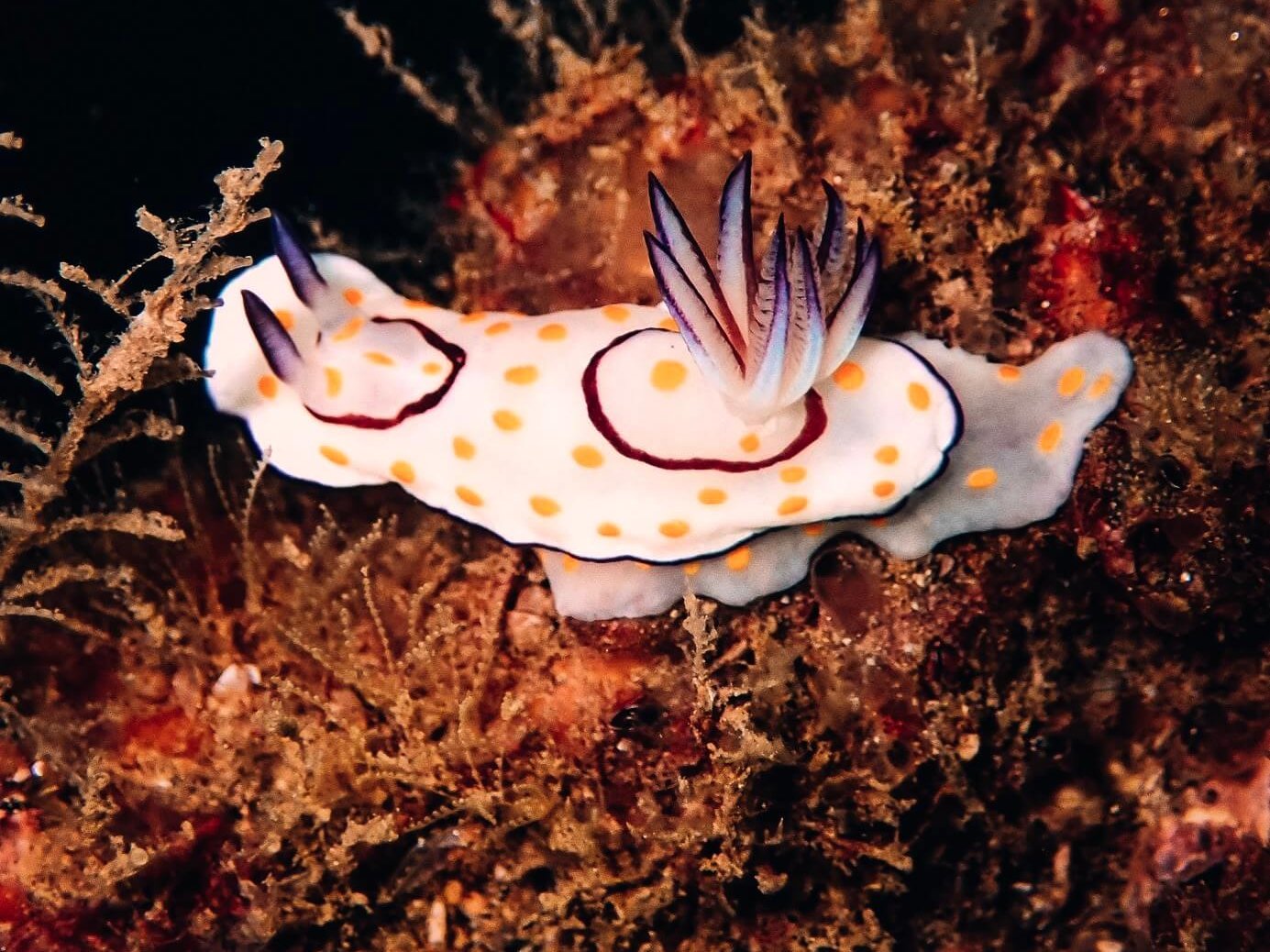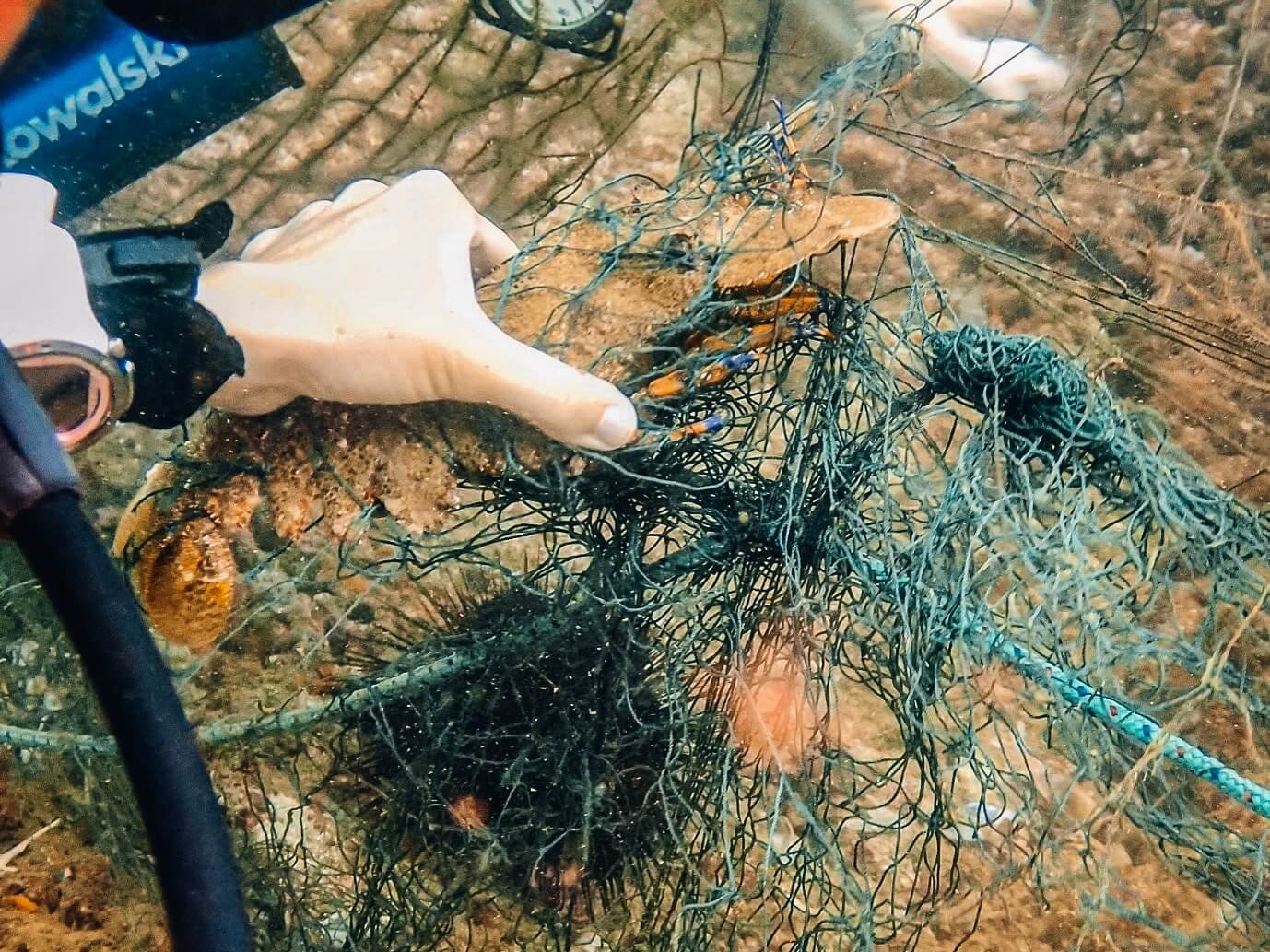A few lovely ladies who also blog and myself recently formed a little group where we swap articles to edit for each other prior to publishing. My first post on Oman came back with a note that said, “Can you add what makes this a good place to dive? As I’m not a big diver myself, I’d love to know why the Gulf of Oman is a good place to dive.” A perfectly fair question, and one that should definitely be addressed if you fancy yourself a halfway decent writer. I had to laugh at it though. Oh, if only I had thought to ask that question prior to traveling halfway across the globe.
When you travel around the world, working in the dive industry, you compile a list over the years of all the questions to ask before taking a job. “Are room and board included?” “What is the wage/salary?” “What is the water temperature?” “How many dives do you offer each day?” “How many courses do you teach each month?” And when it is your friends who are inviting you, the question, “Is the diving any good?” kind of gets forgotten about, because why else would they be there?
And me, I’m overly trusting to a fault, and always eager for any excuse to see a new corner of the globe, so I jumped on the idea of traveling to Oman without ever actually asking the question, “What makes Oman a good place to dive?”
Oh, if only I could have seen my own face when we descended into the unknown that first day in the water. Fletch was guiding one guest. I was going along to learn the dive site, except it’s difficult to learn the dive site when there is no dive site to be seen.
Imagine you are a tour guide in a new city, and trying to learn the route in a dense, dense fog. Now imagine that fog is very green, and cold enough to give you an ice cream headache, and you wonder with trepidation, “Is this normal? Will the weather ever clear enough to see anything on the tour? Surely it must or people wouldn’t come…”
It wasn’t all ice cream headache cold, there were a few meters at the surface of slightly more tolerable water where all the jellyfish were basking in the sun. That’s right, a layer of hundreds of thousands of jellyfish, one that was so thick you couldn’t even push them all away as you swam through. Having been to Palau and Jellyfish Lake, I wasn’t the least bit bothered by them; in fact I found them novel. The guest we were diving with was terrified of them however, and so we had to bypass the warm layer quickly and spend the entirety of the dive in the cold water below. Yes, that is how much I enjoy the cold; I would rather spend my time getting cozy with stinging organisms.
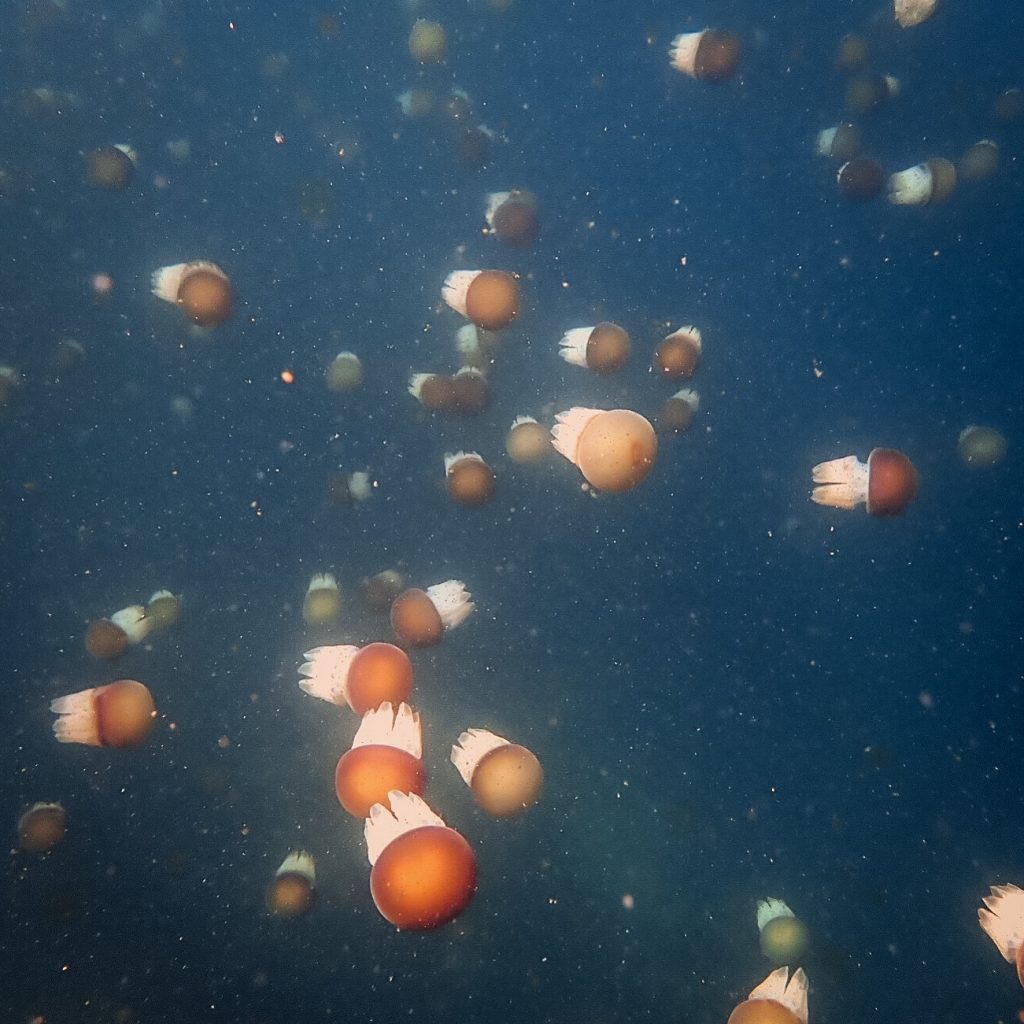
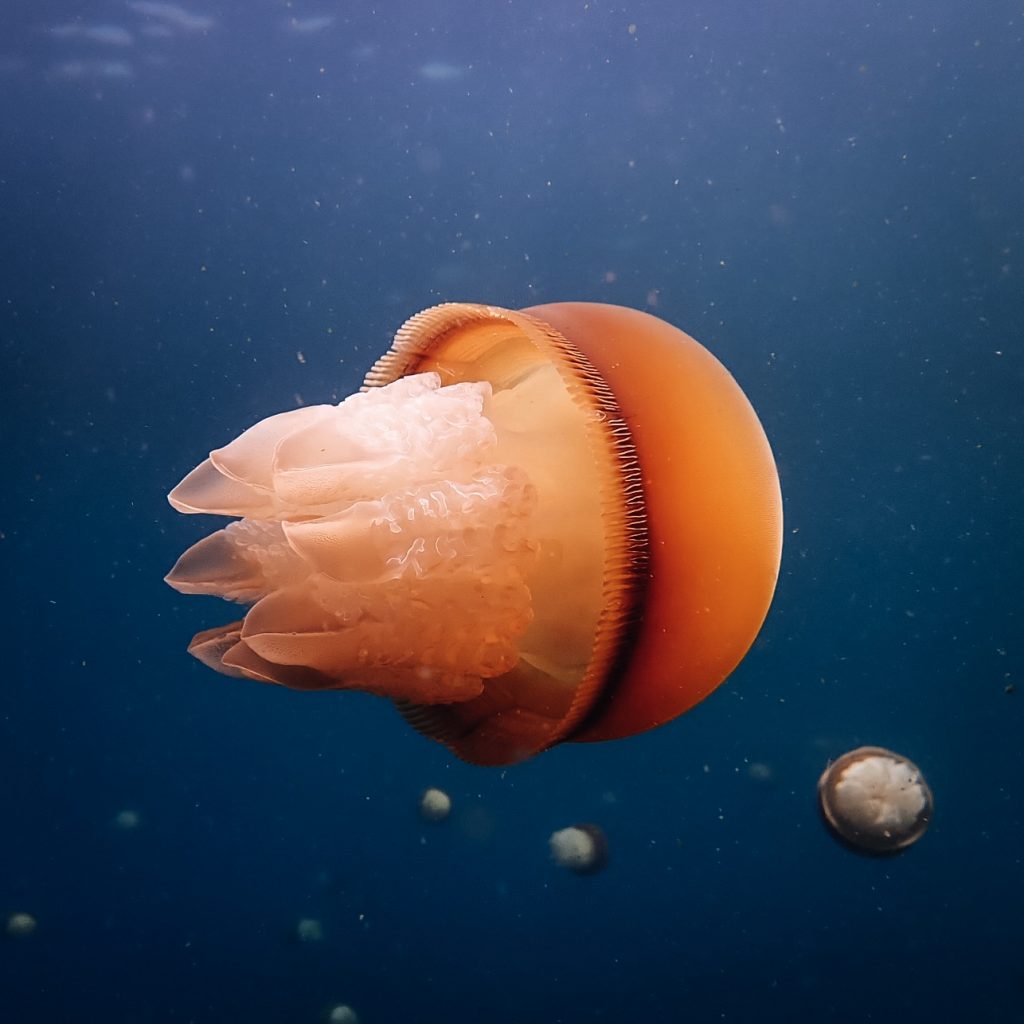
After five minutes of finning through the green murk and realizing there was nothing at the edge of our field of vision except rock, Fletch and I gave each other a look, a horrified, “What have we done?” look, and then carefully avoided eye contact for the rest of the dive, for fear we would would give away our dismay. The guest could not know how horrified we were. The guest had to believe that diving in cold pea soup was as much a novelty as I found the jellyfish to be.
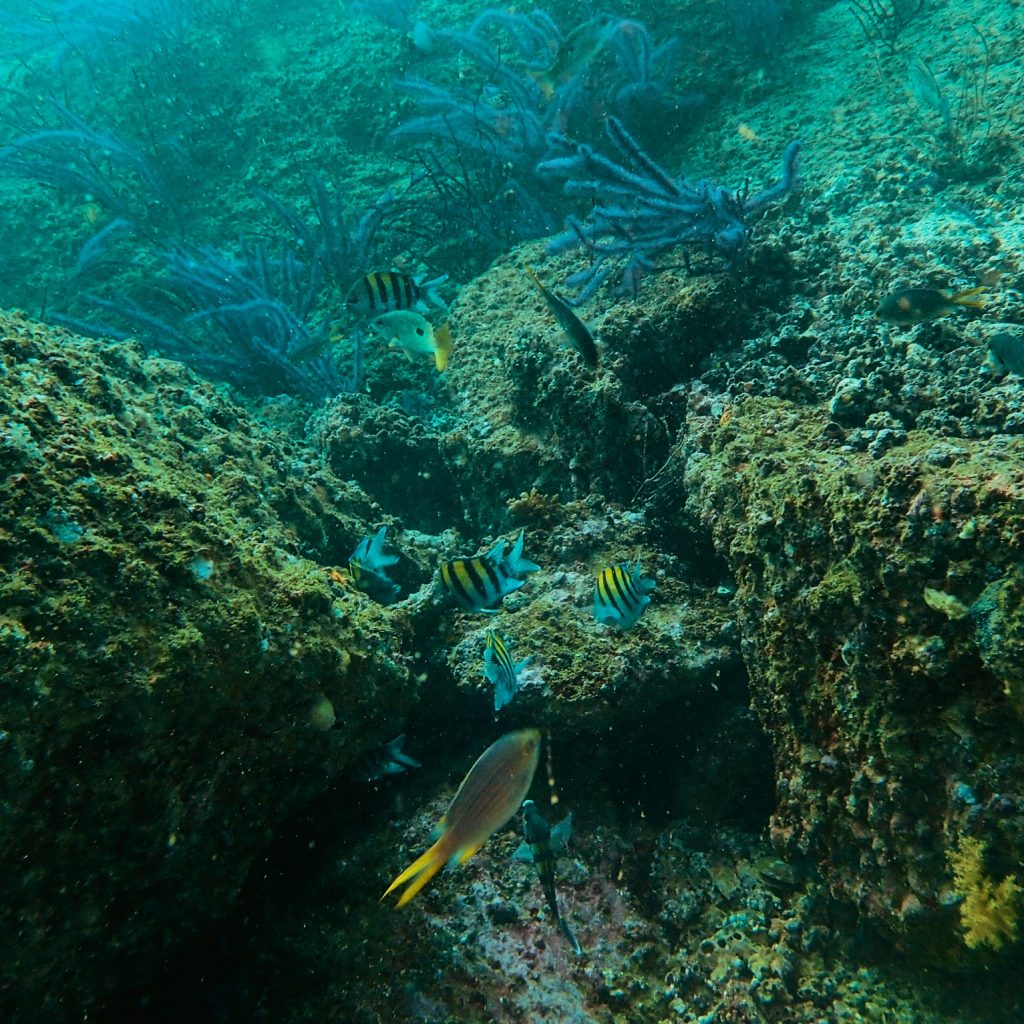
I do believe that was the longest dive I have ever had. I glanced at my computer every half minute, wondering why oh why the time wasn’t moving. And not only were there 49 minutes left of this torment, but I had signed on for six weeks after that.
You may remember a few months back when I was whining over how cold the water was in Manado, Indonesia. (Yes, I realize I am a giant wuss in the cold.) That water was 25 °C. The water in the Gulf of Oman was 23 °C. (That’s 73 °F for my fellow imperial friends.) I know what you’re thinking, boo hoo, 73 still sounds like a perfect summer’s day, but the temperature of the water works a little differently. Water conducts heat away from your body 25 times faster than air does, so anything colder than body temperature (98 °F/37 °C) is going to make you cold eventually. I dare you to find a kitchen thermometer and fill your bathtub up with 73° water and then sit there, fully submerged, for a full 60 minutes. You lose a lot of heat through your head, so make sure that your face is the only thing poking out, or for the full experience use a snorkel. Having fun? Now cover your lightbulb with a green towel.
Our guest told us after the dive that she had just been diving in clear, 30° water in Egypt, and so wasn’t prepared for this. You and me both, girl. She asked if we could cut the second dive short because she was cold. I could have hugged her, but instead just told her to let me know when she was ready to ascend.
The second dive site was a small wreck teaming with life. It had enough new varieties of eels and fish and nudibranchs to distract me from how cold I was, or at least that’s what I kept telling myself. There were also some electric rays I had never seen before. They were funny looking creatures, about the size of large serving platters, covered in leopard print with what looked more like a fish tail than the pointy tail you usually associate with rays. They were called electric rays for a reason, and I couldn’t help but wonder how long I would forget about the cold for if I got zapped. You’re probably imagining these things swimming around, randomly zapping anything they come into contact with now; that’s how people usually imagine creatures with interesting defense mechanisms. You would really have to irritate pretty much anything in the ocean in order to get it to defend itself, electric rays included. I would have to land on one if I really wanted to find out if it was a magical cure for the cold. Don’t worry, I’m not that crazy.
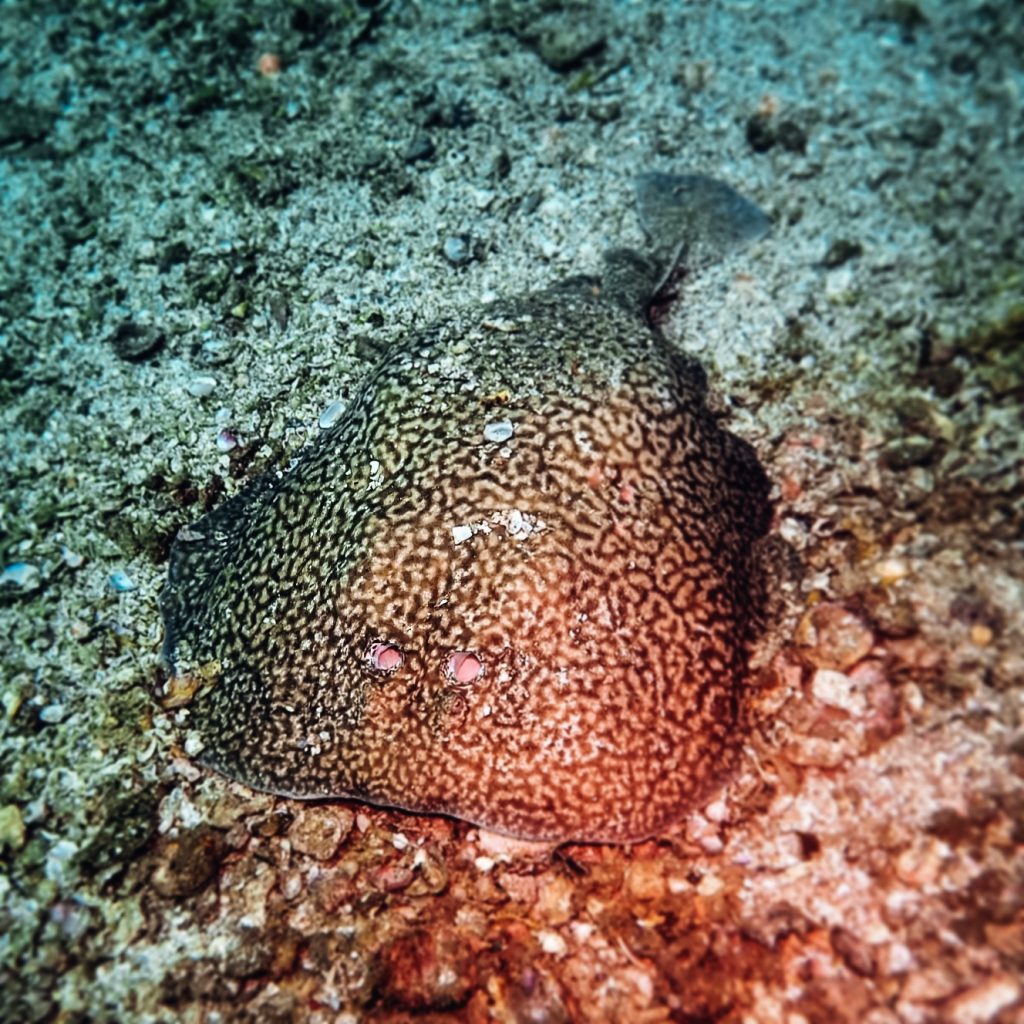
I learned over the weeks that the Europeans really loved the diving in Oman. Many of them were repeat guests. I dove with a Danish lady and her two grown nephews one week, and boy did they come prepared. They looked like a bunch of tech divers by the time they were suited up in their 7mm, semi-dry wetsuits with hoods and gloves and massive torches that they had to strap the separate battery packs for around their legs. There I was, hoodless and shivering, trying to point out a nudibranch with my small pocket-sized backup torch. When they came in for a closer look, the dark, green, murky water suddenly lit up like the sunny desert air above the surface.
Feeling embarrassed that my guests were better prepared for the conditions than their dive guide, I explained that I had come from diving in mostly warm, clear water, such as Thailand. (That wasn’t my most recent home of course, but Thailand was on my mind a lot, as the water there was consistently 30°.)
“Oh,” the lady said with almost a scoff,” “That’s very easy diving, isn’t it?” She said the word easy as though it were a bad thing, and I realized that some people really like the challenge that diving in the dark, cold water presents. It’s a skill level to graduate up to, like skiing a black diamond or something. Good for them.
I learned something about myself over those weeks too. I used to believe that I was a scuba addict no matter what the conditions were. That is not true though. I do not appreciate the “challenge” that diving in dark, cold water presents. Scoff all you want about warm, clear water being easy; my enjoyment of diving comes from the time spent with nature, and it’s hard to appreciate nature when you can’t see it.
I eventually did borrow a 7mm, semi-dry hood from Stefan. That made a world of difference. Like I said earlier, you lose a lot of heat through your head. I also borrowed an additional short wetsuit to layer over the 3mm vest and 5mm long suit I was already wearing. And that’s how my daily routine of getting ready with layers upon layers of neoprene gradually became quite the process.
One of my favorite dives (and by favorite I mean the closest thing to a nightmare I’ve ever experienced underwater), I was guiding this German couple. The lady was Asian and only had about 20 logged dives, which was unusual for Oman. The guests who came there were mostly fairly experienced. It was my first day back in the water after a few days off. Luckily, Stefan had warned me to bring a torch, because the water had been a “little dark” recently. So I charged my primary torch, which is a good one, but still not the softball-sized beam of 2000 lumens with an external battery pack that my Danish divers were carrying around. I suddenly missed them on that dive, because as we descended, the water became darker and darker. It became so black that we might as well have been night diving. In fact, I’ve had night dives that were brighter than that dive, due to the moonlight actually being able to penetrate through the clear water. The fish were even curled up in the rocks, asleep.
The darkness was due in part to whatever green algae was blooming, and due in part to the smack of jellyfish that was slowly congregating above us, blocking out the last hint of sunlight. The jellyfish layer was slowly descending, pushing us downwards and downwards as we tried to stay underneath them, until we found ourselves swimming over a rocky slope. Suddenly, out of the dark rock we were hovering inches above, eels started popping up at us like whack-a-moles. Eels pose no threat unless you’re right in their face, because they have very poor eyesight. But we were blind as well, and so couldn’t see them until we were right in their faces. So there we were, blind in the dark, caught between a rocky slope full of eels and a swarm of jellyfish overhead. 1270 dives gives you the level-headedness to realize you’re not in any danger of course, but I always try to see my surroundings through the eyes of whom I’m diving with, and for someone with 20 dives, the scene was straight out of a nightmare. I was highly impressed when the Asian girl didn’t give up diving right then and there.
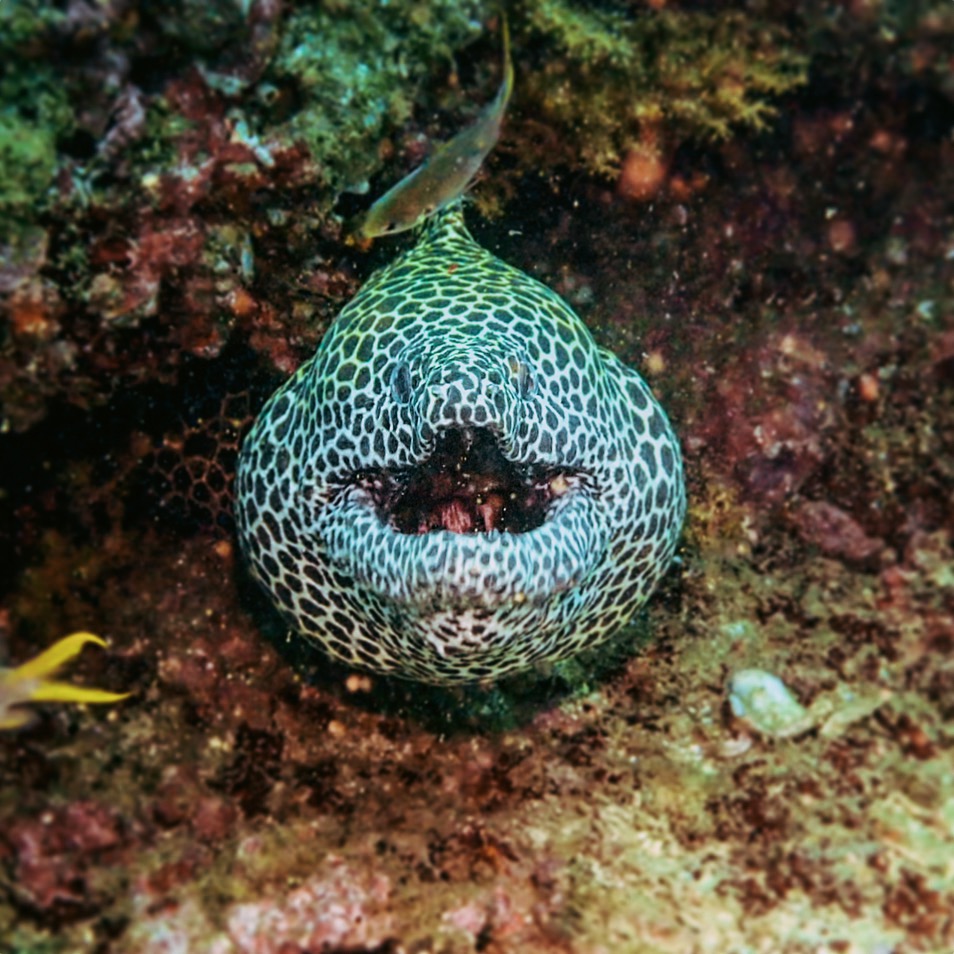
Head diameter: size of a small pizza.
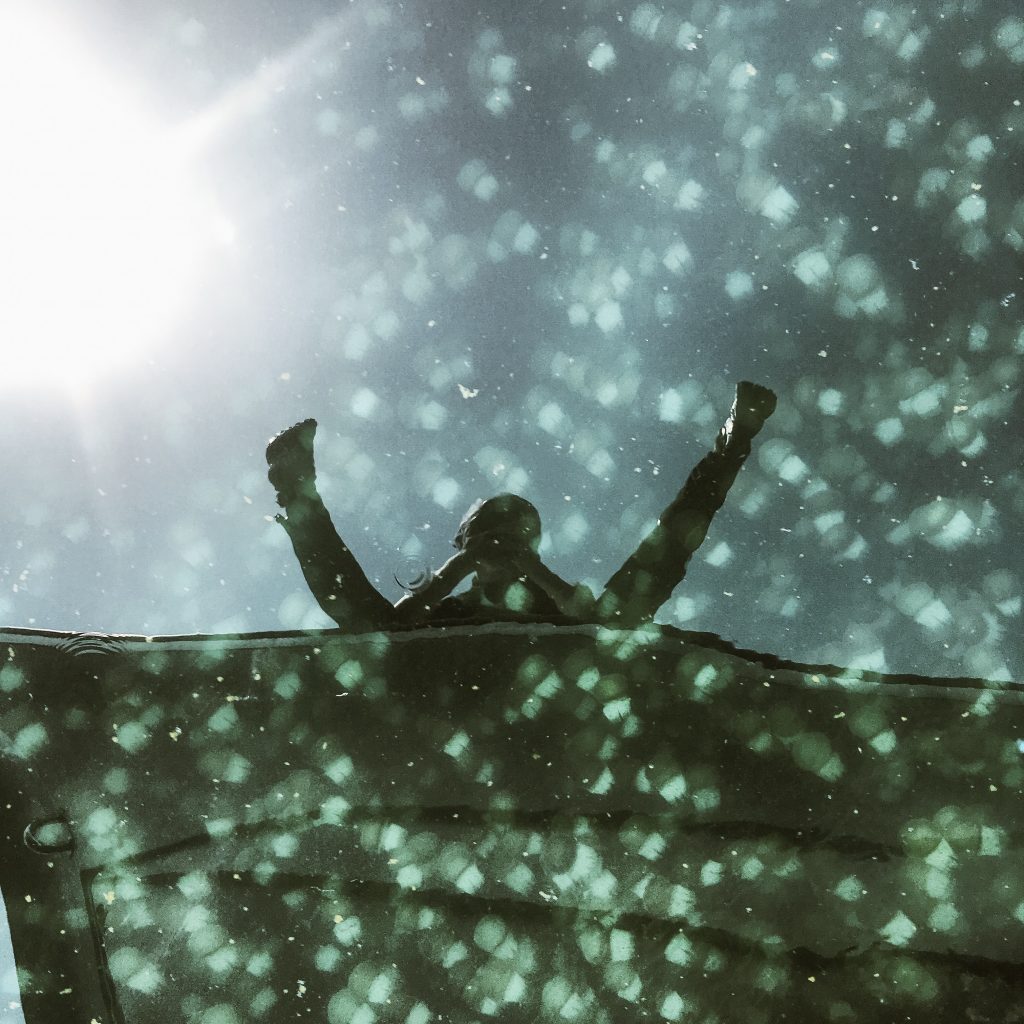
Several weeks in, Stefan made the comment, “You’ve been very lucky with your timing so far.” I thought maybe he was referring to the fact that it was whale shark season, as we were about to go on a snorkeling tour to try and see whale sharks. Then he started listing off all the things about the diving I’ve just described: the jellyfish, the cold, the bad visibility… and I realized he was being sarcastic. It also came as news to me that these weren’t the normal conditions. After a month of diving in such conditions, during what was supposedly high season, I had just assumed that cold, murky water full of jellyfish was the norm. Surprise again!
So before I offend our friends who invited us out to Oman any further, know that there are more posts coming that highlight the more favorable aspects of the diving! It wasn’t all bad. There were a lot of new fish I got to meet.
Guests favorite question to ask their dive guide is, “What are we going to see?” The smart-ass reply is, “It’s the ocean; the only thing I can guarantee is we won’t see any elephants.” (Fletch gets the credit for that one).
I used to at least always be able to say with some degree of certainty what the temperature and visibility were going to be. In Oman, that all went out the window. I never knew water temperature could vary so much from day to day. We experienced everything from 21°, to a seldom, random, 30° day for no rhyme or reason. The visibility was anywhere between might-as-well-be-a-night-dive, and the seldom, wait-did-I-just-transport-back-to-Fiji? There wasn’t much in the way of hard coral, but some of the soft corals were interesting. And the fish life was breathtaking when you could actually see them.
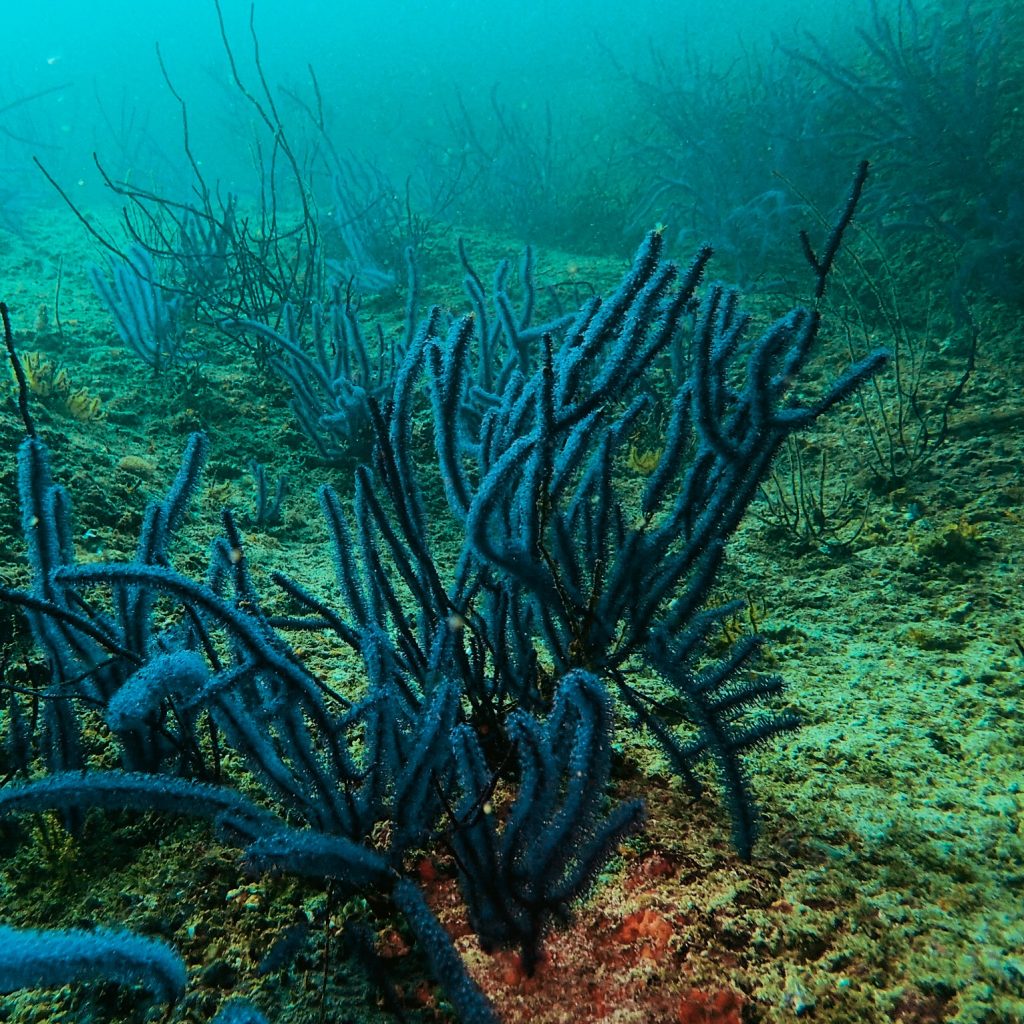
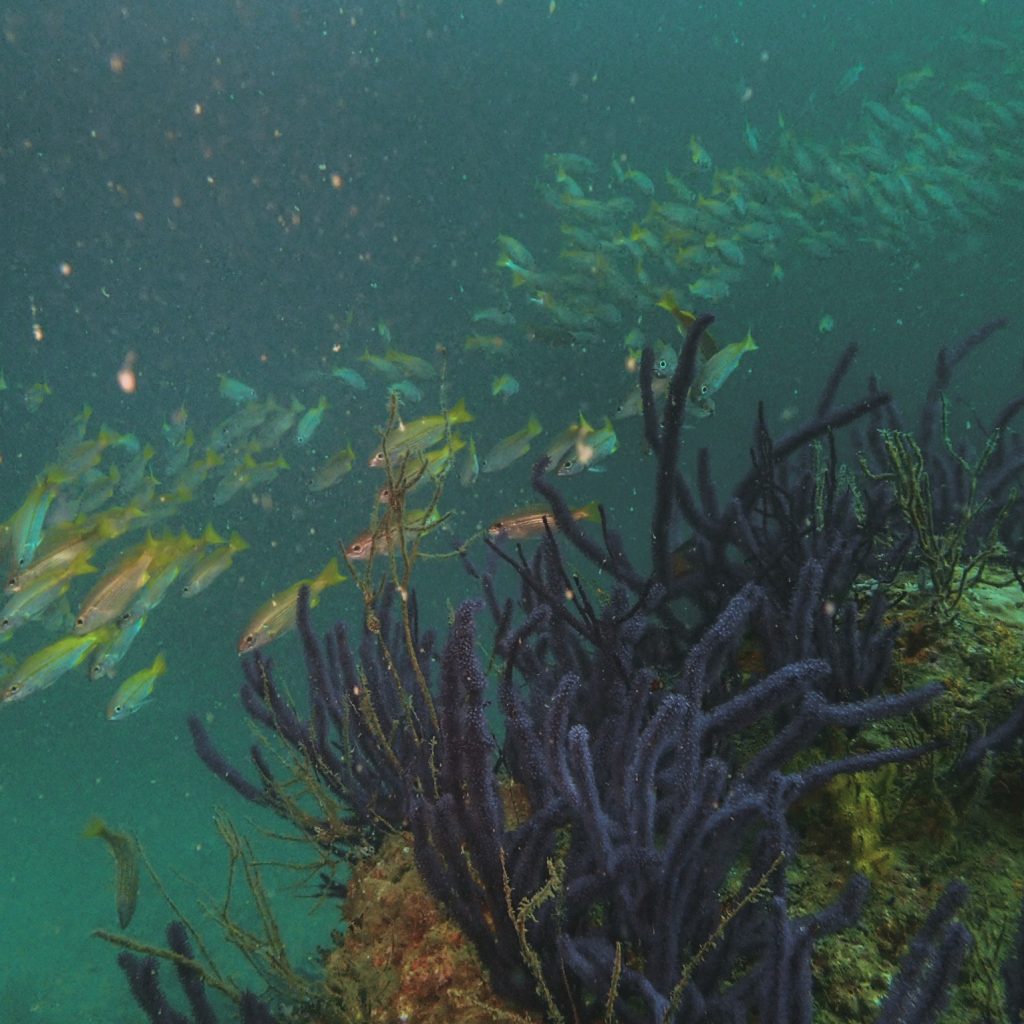
Overall, the diving in Oman is like shopping at a thrift store. Some days you’re in a grungy warehouse that forgot to pay the electricity bill, looking through faded clothes. Some days you find that a rich sorority girl just did her spring cleaning and dropped off her entire designer wardrobe. You never know what’s going to happen until you’re in the water!
Alright, I couldn’t very well complain about the diving and post a bunch of cool pictures at the same time, so that will be all for the bellyaching; stay tuned for the finer points of diving in Oman, with better photos.



